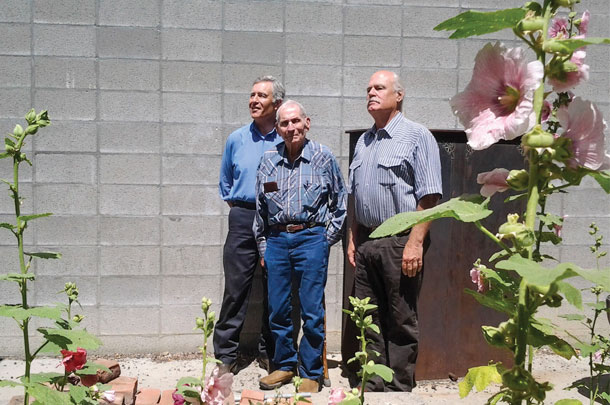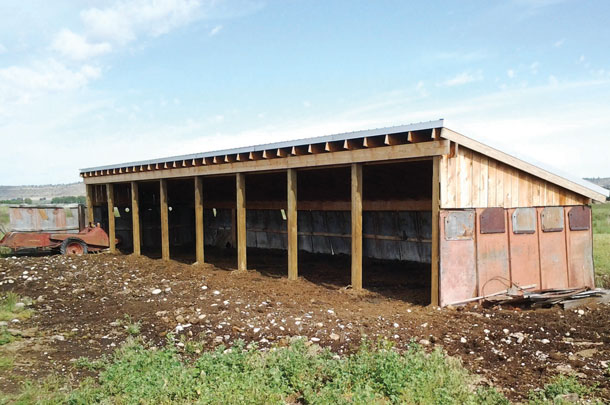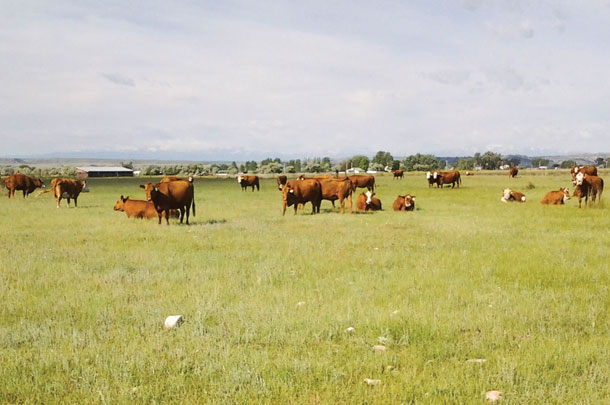For the past 15 years, the Yegen family has used a small herd of Red Angus-Hereford crossbred cows covered by Red Angus bulls as part of their ranching and marketing strategy – fall calving. The calves start dropping mid-September. The 50 cows on the autumn roster are 20 percent of their cow-calf operation in the Yellowstone River valley west of Billings.
While Yegen lists several advantages to the contrarian cycle, he also throws in an intangible: luck. Early winter storms on the Great Northern Plains can decimate herds of cattle and sheep. Yet with a keen sense of how weather patterns were changing, and having the resources to implement an experiment, the family embarked on a process that has brought it success.
“Appropriate stocking rate” is a key component to the overall plan, he says. “There is limited capacity.” The fall nursery is 300 acres of sub-irrigated pasture. A drastic reduction in Russian olive stands also was a huge benefit in freeing up more grass for the cattle. Enough trees remain to provide shade during the summer heat.
“Two paychecks a year” is at the top of the advantages, says Yegen, plus the bulls go to work twice a year. The incentive for them in cold dark December is not quite as inspiring as cool summer mornings, but “we don’t need as many bulls” with the split breeding season, he adds.
Yegen explains that fall calves coming to market the next spring enter a steady market if not an enhanced price. “These calves are ready for grass or the feedlot,” he says. “There is not usually a big difference in price.”
But cattle prices in the past couple years – bred heifers or not – are a bit skewed to the top end now, as producers from around the county converged on Billings auction markets looking for heifers and young stocker cows this past January, February and March. This is a measure of the value of grass in states recovering from drought.
The two-season method also allows for options with an open cow. If she fails to breed or loses a fetus, she can be put into the fall cycle. “A good, younger cow, we keep her,” notes Peter Yegen IV, Charlie’s older brother. The herdsmen have always raised their own replacement heifers.

By breeding the cows in December there is no added feed cost, in that summer pasture on good grass is adequate. Among the lower input costs are reduced labor and “the cows spread their manure themselves,” Charlie says, laughing.
A retired truck driver lives on the site and looks after the animals. There is a calving shelter if needed, “but generally, we don’t use it. They are like deer, they calve in the grass,” explains Charlie.

The family emphasizes genetics for both herds. “There is a predictability that we’ll not have calving problems,” says Peter IV, as close attention to sire EPDs is essential.
Calves born in the fall are weaned in May. “They come right off the cow into the public auction yards and are ready to go to grass or the feedlot,” Charlie says.
The family’s philosophy in producing cattle is summed in the words of Peter Yegen III, 96, father of the brothers: “A good price for us goes down the line” to the next segment of beef production.
The family heritage extends back to territorial days, when Edward Cardwell brought Hereford cows into Montana in the 1880s. Peter III’s mother, Zellah Cardwell, brought cattle production into that generation of the Yegens. Peter Yegen, Jr., was an entrepreneur of note in the Yellowstone valley involved in real estate, insurance and livestock production.

Charlie admits to a few drawbacks. Raising young calves in winter can be a challenge. “An early, long winter would be difficult,” he says, but by Jan. 1, a 3-month-old calf is growing on milk and hay. On the flip side, vet bills are lower because of fewer complications when the weather is good at birth.
The genesis of the project was personal observation of the changing weather patterns in the mid-1980s. “Fall calving started as a way to be efficient,” Charlie explains. “We were very cautious, and it has been a smart move ..... until we have a bad winter.” In recent decades, autumns in the Yellowstone River valley have been mild and favorable to newborn calves.
Megan Van Emon, Montana State University Extension beef specialist at the Fort Keogh Livestock and Range Research Laboratory in Miles City, has a checklist of pros and cons for producers considering a fall calving program.
On the plus side, she sees a great opportunity for price premiums on calves sold in the early spring, as they can be held for yearlings or stockers. Double use of bulls offers an advantage, but she suggests virility testing as a caution.
Dropping calves in August or September is fine, but she would worry about going deep into fall.
Among the drawbacks, there is a question of labor, as many producers may also be harvesting crops at the same time. Nutritional values of fall forages might be detrimental to the peak lactating period when there is a need for energy and protein. Then there is the chance of severe weather.
Emon cautioned against pushing an open spring-calving cow into the fall herd. She would prefer culling the cow if she does not get pregnant when bulls are turned out in May/June.
Emon’s checklist pretty much mirrors the Yegen family experience. For those producers who have the natural resources and labor, fall calving is a useful marketing strategy at a time when there is a beef-cattle shortage in the U.S. and the world.
Jim Gransbery is a freelance journalist based in Billings, Montana.
PHOTO 1: Close-up of cows in lush grass in sub-irrigated pasture. Yellowstone River rimrocks in background.
PHOTO 2: Left to right: Charlie Yegen, Peter Yegen III and Peter Yegen IV.
PHOTO 3: Calving shelter
PHOTO 4: Panorama of Yegen fall-calving herd west of Billings, Montana with Beartooth Mountains in background. Photos courtesy of Jim Gransbery.







